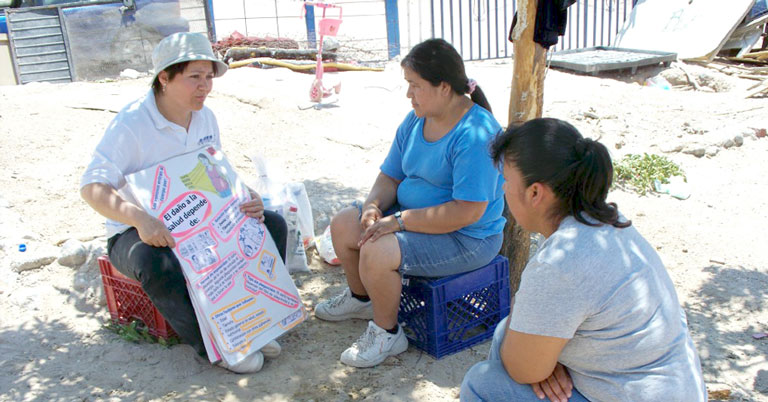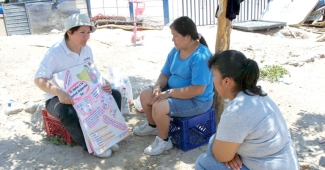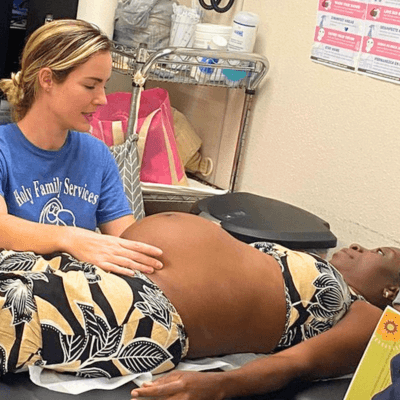Community Health Workers: An Essential Link in Farmworker Health Care
 By Amy K. Liebman, MPA, MA, Director of Environmental and Occupational Health, MCN and Claire Hutkins Seda, Writer and Editor, MCN
By Amy K. Liebman, MPA, MA, Director of Environmental and Occupational Health, MCN and Claire Hutkins Seda, Writer and Editor, MCN
[Editor’s note: We offer this blog post ahead of our May 25th webinar for Community Health Workers on heat stress: “Antes de los días de verano, aprenda cómo los Promotores de Salud pueden ayudar en prevenir enfermedades a causa del calor.” Register for the webinar here.]
Over ten years ago, Carlitos Candelario was born without legs or arms. Carlitos was one of three babies born with severe birth defects within a span of seven weeks; all three mothers worked in the same tomato fields, and lived in migrant housing within 100 feet of each other. An outreach worker from a local clinic, with a good pulse on the overall community and its residents’ concerns over these birth defects, sounded the alarm. As a result of her efforts, public health authorities launched epidemiologic exposure assessments. While some of the assessments did not support a causal association between the birth defects and the mothers’ pesticide exposure, the North Carolina Department of Health did find the association in the case of Carlitos. These cases gained national attention, and eventually AgMart, the company employing the pesticide-exposed women settled with Carlitos’s family.
But what if there wasn’t an outreach worker in this case? Roughly 55 percent of US babies are born in states that do not have mandatory birth defect reporting. Only a handful of states require clinicians to report birth defects, weakening the ability of health authorities to pinpoint birth defect hotspots.
Additionally, many clinicians lack the education, tools, and resources to properly diagnose pesticide exposure, which lessens their ability to follow pesticide reporting protocols. In a recent Migrant Clinicians Network report (written up at the end of this issue of Streamline), nearly half of the 101 clinicians polled stated they had one hour or less of education in environmental and occupational health and 70 percent had four hours or less, before MCN provided a training. Just as concerning, half of the clinicians at the start of the training were unaware of the laws in their state requiring the reporting of pesticides. Indeed, in the AgMart case, the medical director of the health center where the women were treated said, “The truth is, pesticide exposure was not even on my radar.”
Luckily, there’s an entire workforce dedicated to bridging that gap between the medical establishment and the community itself. Community health workers (CHWs, also called promotores de salud) and outreach workers are part of a health center’s enabling services, with diverse day-to-day duties; some go to migrant farmworker camps to provide basic health education and screening, others provide transportation to clinics, others interpret, and still others provide social support. But they all aim to increase their communities’ access to and use of health services. Because CHWs are usually from the community they are serving, they can diminish the language and cultural barriers that may exist between a community member and her health provider. Integration of CHWs into the primary care team continues to assure that underserved populations like migrant farmworkers are provided avenues to receive the health services they need.
But beyond the basic job description, CHWs provide a vital service in seeing overall health trends and concerns of the community, and facilitating the conversation between the community and local clinicians. AgMart is just one example. In Austin, Minnesota, multiple employees of pig processing plants were suffering from a mysterious and serious nerve disorder. Just as in the AgMart case, a non-clinician -- in this case, a Spanish language interpreter -- was the first to alert authorities of the link between the cases -- they shared the same occupational exposure to the mist of pig brain tissues. (Ted Genoways wrote extensively about meatpacking plants, the increasing speed of processing, and its impact on workers, and about the workers suffering from these nerve disorders, in his book, The Chain.)
How many more illnesses and injuries go unnoticed, in regions that lack a healthy CHW program? When it comes to health justice for underserved communities like migrant farmworkers, CHWs are an essential component to the clinical team. Migrant Clinicians Network supports clinics in integrating CHWs into primary care:
- Join our Spanish-language webinar series for CHWs. The next installation, entitled “Before the dog days of summer, learn how community health workers can help prevent heat stress,” is presented on May 25th at 1pm Eastern time.
- MCN’s Archived Webinars for CHW on Worker Health and Safety
- MCN’s Train the Trainer and Patient Educational Materials for CHWs
- Learn more about the benefits of CHWs and outreach workers in MHP Salud’s article, entitled “Including Community Health Workers in Clinical Teams,” printed in the Winter 2016 issue of Streamline.
- Check out our webinar archives for the ten-month, highly rated webinar series from 2015 for CHWs, on the principles of public health.
Like what you see? Amplify our collective voice with a contribution.
Got some good news to share? Send it to us via email, on Facebook, or on Twitter.
Return to the main blog page or sign up for blog updates here.
- Log in to post comments






